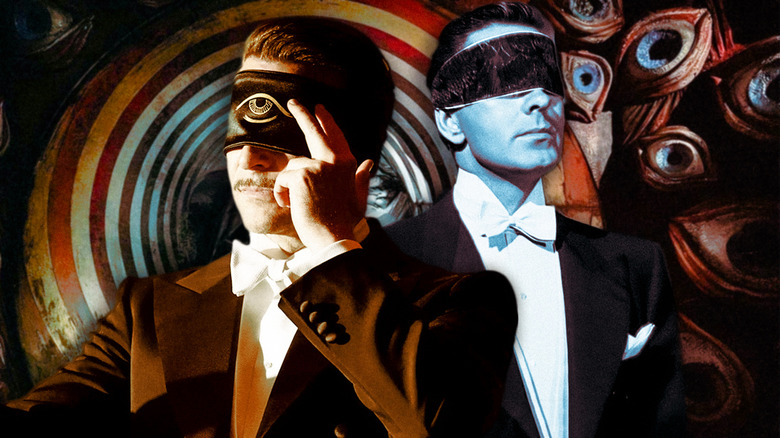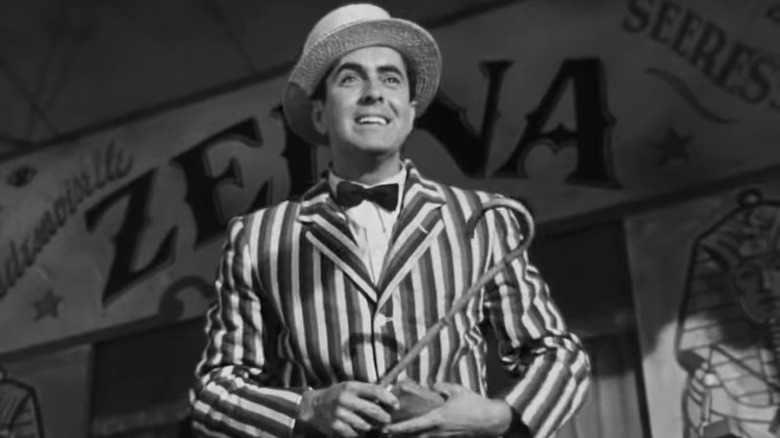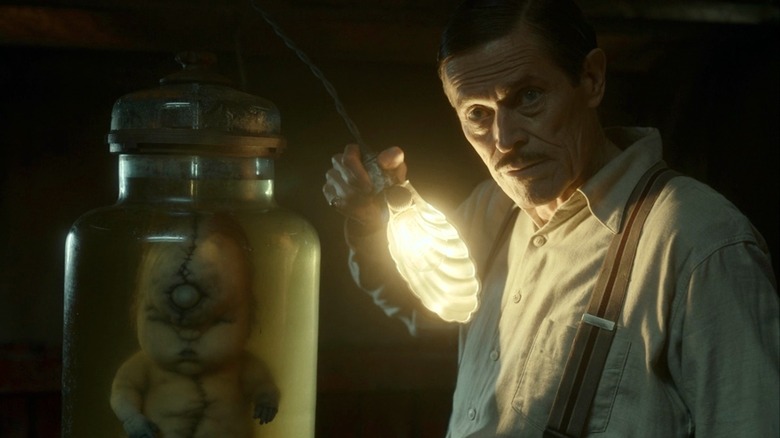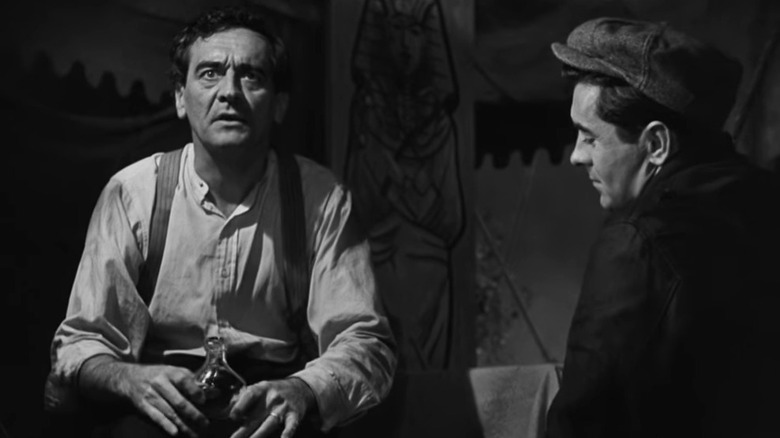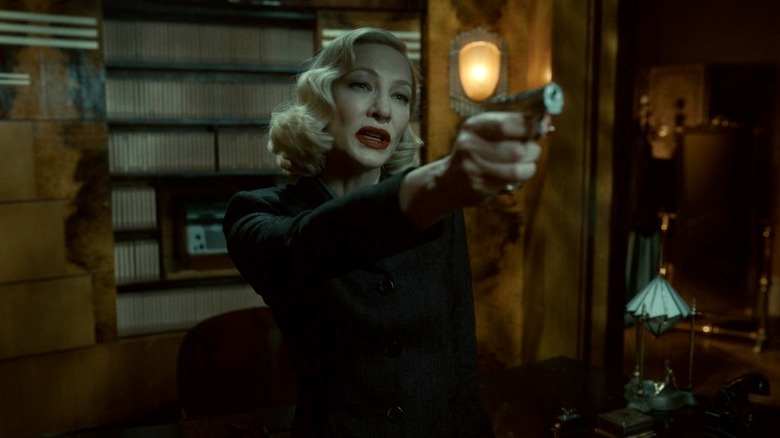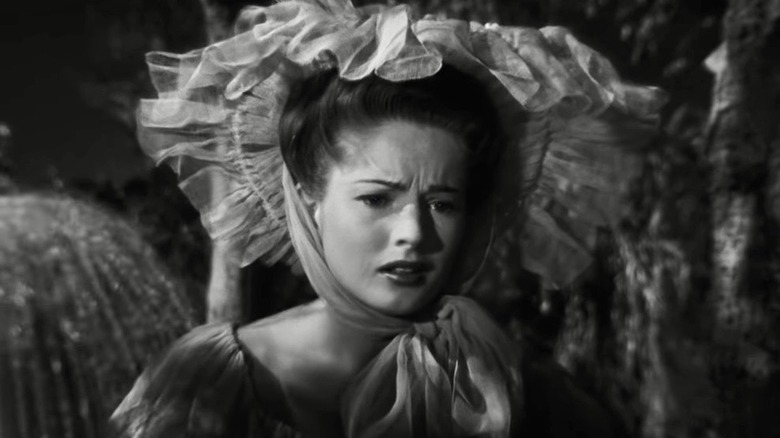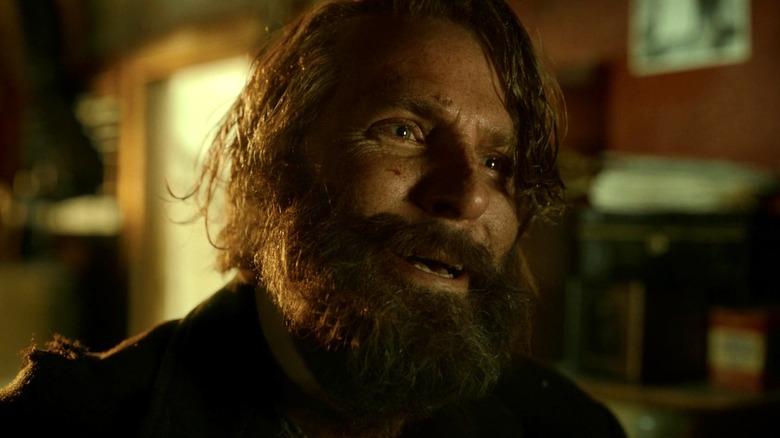All The Major Differences Between Guillermo Del Toro's Version Of Nightmare Alley And The 1947 Original
Though it received a Best Picture nomination at the 94th Academy Awards in 2022, Guillermo del Toro's re-adaptation of the William Lindsay Gresham novel "Nightmare Alley" hit theaters the same day as "Spider-Man: No Way Home" and was overshadowed by that movie's juggernaut success amid the pandemic. It makes the most of those shadows, though, filling them with smoke and "the poetry of disillusionment and existentialism," as del Toro has called it. This is a movie that lives at the carnival, where you're less likely to see any spider-men and more likely to see a woman with a spider's body warning children about the sins of lust and pride.
Co-written by Kim Morgan, the del Toro version of "Nightmare Alley" takes its cues from Gresham's book and was not intended as a remake of the black-and-white 1947 adaptation starring Tyrone Power. However, that movie is a classic and it's worth examining how del Toro updated things for the 21st century while keeping the setting rooted in 1939 and 1941, when World War II was happening even as early film noir was building off German Expressionist influences.
Like Dr. Lilith Ritter (Cate Blanchett), we've been taking notes, but to do a full comparison between the two movies, we'll need to go into spoilers – so look away now if you happened to stumble down this dark alley without having seen "Nightmare Alley." Del Toro's film uses old-school techniques like iris shots to tell its story visually, but as it charts its self-serving protagonist's downfall, the moral of the story is very different. It all goes back to that question of how a man gets so low, and a crucial conversation that details how a carnival barker enslaves broken-down men to their vices.
The movies begin quite differently
The 2021 adaptation of "Nightmare Alley" has a much different start than its 1947 predecessor, as we see Bradley Cooper's antihero, Stan Carlisle, dragging a body across his house and dumping it in a hole in the floorboards before setting the place on fire. In his brown fedora hat and jacket, he almost resembles Indiana Jones, but as the movie goes on it feels more like an archeological expedition into the furthest recesses of Stan's mind: unearthing his past and the parts of his psyche he keeps hidden, even from himself.
Power's 1947 version of Stan is already a member of the carnival and having an affair with the mentalist Zeena (Joan Blondell) when the movie begins. Within the first 10 minutes, he's heard about the code she and her husband Pete (Ian Keith) once used in their vaudeville act. Stan sees the feral Geek (George Beranger, uncredited) and "can't understand how anybody could get so low." He also sees "those yokels out there," the carnival attendees, and it gives him "sort of a superior feeling." From the very beginning, writer Jules Furthman and director Edmund Goulding put Stan's hubris on display.
Cooper's character, by contrast, doesn't say a word for the first 11 minutes of "Nightmare Alley." The movie takes its time peeling back the onion layers of this drifter and mystery man as he gets off the bus and follows Major Mosquito (Mark Povinelli) into the carnival, where the strongman Bruno (Ron Perlman) hires him. There's a spacious quality to del Toro and cinematographer Dan Laustsen's camerawork, and this extends to the movie's running time, which is 40 minutes longer than the original.
Events are reordered and more R-rated
In del Toro's version of "Nightmare Alley," the carnival barker Clem (Willem Dafoe) acts as a welcoming committee for Stan and the audience, inviting them to "come on in and find out" if the Geek (an unrecognizable Paul Anderson, of "Peaky Blinders") is a man or beast. We get a similar spiel in the 1947 film, albeit with more old-fashioned costumes like a candy-striped barker's jacket and leopard-skin strongman's leotard. There's also less graphic violence and overt sexuality, which is understandable given that Hollywood was under stricter censorship courtesy of the Hays Code in the 1940s.
It's only in the 2021 version that you'll see the Geek bite the head off a live animal as if he were Ozzy Osbourne. That's not the only new grotesquerie; there's also the addition of Clem's pickled baby (a prop del Toro keeps on display in his house), which comes back into play at the end of the movie. The whole bathtub scene is new, too, with Toni Colette's Zeena coming on stronger, bringing her dalliance with Stan out into the open in a way that Blondell could only do with a tame '40s kiss.
As part of a general reordering of events, del Toro has the Geek escape early on — something we don't see until the climax of Goulding's film when Stan himself has become the Geek in a different carnival. He then has Cooper's character follow the Geek into a funhouse called the House of Damnation, where he passes a mirror with the words, "Take a look at yourself, sinner." This foreshadows his fate, something the 1947 original accomplishes by having Zeena give him a tarot card reading and see the Death and Hanged Man cards much earlier.
New emphasis on father figures
In Edmund Goulding's adaptation of "Nightmare Alley," Stan reveals in dialogue that he grew up in an orphanage and ran away before landing in reform school, where he charmed the chaplain by feigning religiosity. There's no mention of his father, whereas del Toro makes the old man an important plot point, inserting flashbacks and juxtaposing images of him dying with the Geek, as Stan gets a hint of his own degenerate future. As del Toro fleshes out his backstory more, it's revealed that Stan let his father die of hypothermia on purpose — and that's not the only death he'll have a hand in.
There's also David Strathairn's Pete, who has a beefed-up role as Stan's carnie mentor and replacement father figure. Pete teaches Stan how to do stock readings and adds to the foreshadowing, telling him, "You never do a spook show. No good comes out of a spook show." He also warns how his code book can be misused and how "people get hurt" when a man starts believing his own lies. "When the lies end," Pete says, "there it is. The face of God staring at you straight."
The 1947 version makes it clear that the wood alcohol switch leading to the death of Ian Keith's Pete is an accident. Del Toro leaves it ambiguous as to whether Stan intended to poison Pete, though he harbors guilt over his death and later says it was a mistake. At the same time, Stan seems to rationalize Pete's death, saying, "He had his fair shake, he just blew it." It's implied that Stan may have been abused or neglected by his father, as Pete talks about learning to read people as a child "to stay ahead of whatever tormented you."
Del Toro ups the danger quotient
Stan's relationship with Zeena ends badly in the original "Nightmare Alley," as she learns of his relationship with Molly (played by Coleen Gray in 1947 and Rooney Mara in 2021). In del Toro's film, which spends the full first hour in the carnival before jumping ahead two years, they part amicably and she's not there when Bruno is beating Stan up.
The imagery of Stan performing in a blindfold, as he moves on to bigger and better grifts, is similar in both versions of "Nightmare Alley," but a funny thing that's not as much emphasized in the new one is Stan's stage name, the Great Stanton, which sounds a little too close now to Hugh Jackman's "The Great Danton" in "The Prestige." In the 1947 version, meanwhile, the Hanged Man tarot card comes back into play later — as opposed to being introduced for the first time — when Zeena and Bruno visit Stan and Molly. Stan kicks them out and calls them cheap carnival freaks, and the card drops on the floor, landing face-down (instead of upside-down on the table), which the movie has established as a bad omen.
Del Toro's version finds other ways to continue teasing that Stan has a bad end coming. As Blanchett's aforementioned Dr. Lilith Ritter seduces him with alcohol, she tells him that dealing with the rich yet menacing Ezra Grindle (Richard Jenkins) has "consequences." Lilith, Grindle, and his right-hand man Anderson (Holt McCallany) become more prominent antagonists over the last hour of the movie. Grindle subjects Stan to a lie detector test and Stan manages to squeeze out of it using privileged information that Lilith has supplied him, but afterward, she again warns, "If you displease the right people, the world closes in on you very, very fast."
Religion is downplayed
One of the many added fatalities we see in del Toro's "Nightmare Alley" is Felicia Kimball (Mary Steenburgen), a judge's wife who kills her husband and then herself so that they can reunite with their son. In the 1947 original, Stan does become involved with a high-society woman who lost her daughter, but there's not as high a body count and we don't see Stan beating Grindle to death or running over Anderson (who's not a character in the original) in his car.
The 1947 version also weaponizes religion more. Stan has read the Bible and can recite the Ten Commandments backwards; he talks about building a tabernacle, making converts, and having his own radio station. Molly fears that he's "going against God" by scamming people with things "sacred and holy." She's afraid God might strike him dead, but Stan continues talking like a radio evangelist, speaking of Grindle (Taylor Holmes) as a man whose "faith is trembling in the balance, a man who was a confirmed skeptic about anything related to religion."
The original Grindle is not as evil and abusive towards women, and Cooper's version of Stan is himself a skeptic, openly disdainful of religious hypocrisy and "tall tales about Jesus and a happy afterlife." He uses "Bible talk" while conning people, but apart from Pete's ramblings, the 2021 film leaves religion in the background more.
When the original Molly masquerades as the ghost of Grindle's lost love, she has a crisis of conscience that leads her to reveal the hoax of her own volition. This and her underlying sense of religious morality contribute to the 1947 film's ending, where "Nightmare Alley" answers its own question about how a guy can get so low by saying, "He reached too high."
'Mister, I was born for it'
1947's "Nightmare Alley" reunites Stan with Molly and gives a glimmer of hope for his redemption at the end. He still meets his match in Lilith, gets outmaneuvered by her, and becomes a fugitive from justice, but he doesn't lose an ear, and his self-imposed exile from humanity seems temporary.
Del Toro's "Nightmare Alley" has a much darker ending. There's a fleeting moment earlier where we overhear Funhouse Jack (Clifton Collins Jr.) luring people into the House of Damnation by saying, "Heaven and hell, find out what it feels like, right here on earth! Let the mirror show you who you are and who you shall be." In a 2017 interview with NPR, del Toro said:
"I don't think there is life beyond death, I don't. But I do believe that we get this clarity in the last minute of our life. The titles we achieved, the honors we managed, they all vanish. You are left alone with you and your deeds and the things you didn't do. And that moment of clarity gives you either peace or the most tremendous fear, because you finally have no cover, and you finally realize exactly who you are."
This is pretty much what Stan experiences in the final moments of "Nightmare Alley," as he surrenders himself to the fate of an animalistic carnival Geek with the line, "Mister, I was born for it." It means more when Cooper's Stan starts drinking again because he made it a point of pride before that he never drank, so as not to end up like his father. For him, there's not much of a life beyond that last line, which is why the movie ends there and doesn't continue on for another whole scene like the original does.
